Optimizing Strength and Conditioning Training for BJJ
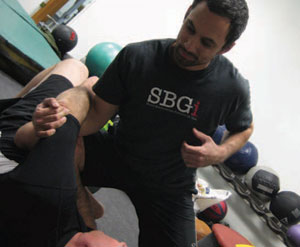
In the past four years of studying Brazilian Jiu-jitsu (BJJ), it has been one of the most rewarding and also one of the most challenging physical endeavors of my life. BJJ is a complex sport requiring a wide spectrum of physical abilities. Small and precise body movements can literally make the difference between a technique succeeding and failing. Strength, endurance, coordination, balance, and explosiveness are just a few of physical capacities needed. For the amateur athlete, balancing BJJ, outside strength and conditioning, and a regular life can be overwhelming. But it is possible.
I work a regular 9-5 job and have limited time to train. Most of it takes place on the evenings and weekends. I can't eat, sleep and train like a professional. I am no longer in school, so no more going to class two days a week and training the rest of the time. I miss those days, but can still make the best of my current schedule.
I would like to give credit to others that have influenced my thinking on training for combat sports. I have absorbed information from a lot of sources, but two main ones have been Ross Enamait and Robb Wolf. I have really gotten a lot out of reading their writing over the past few years and applying things to my own training.
Priorities
First, as a BJJ practitioner you need to use your S&C to supplement your sport, not treat it as a sport in and of itself. The final word that matters is performance on the mat. I have this problem myself. I go into Crossfit Portland and want to do as well as the folks who only do Crossfit. This often isn't going to be the case. You may be fatigued from a grappling practice previously, or just not able to spend as much time on outside training as other folks. That's perfectly fine, as everyone has different goals.
Grappling involves many different strength qualities, which can make it kind of confusing to train for at first. Maximal strength, explosive strength, muscular endurance, as well as high levels of aerobic and anaerobic conditioning are needed. This multi-faceted approach requires a different training approach than for a lot of other sports.
For me, the most important thing to get in grappling shape is to grapple. No amount of extra work replaces time on the mat. So it's important to figure out how much grappling practice you want to attend, and then base your extra work around that. For me, 3 times a week is the minimum required to maintain a consistent level of BJJ. Any less and my timing and technique start to feel sluggish, and my mat-specific conditioning starts to deteriorate. That leaves me three other days for extra training, as I need at least one day a week to sit on the couch.
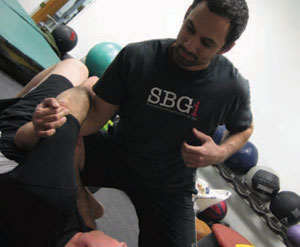
Laying It Out
Here is an example of what my typical training week looks like.
Sunday
BJJ open mat: 2 hrs
Monday
Strength day, plus quick finisher.
Tuesday
Off
Wednesday
Metcon: Usually something demanding utilizing weighted implements.
Thursday
BJJ class: 1.5 hrs
Friday
Another metcon: something a little less demanding than Wednesday, or utilizing different modalities
Saturday
Sometimes a Metcon in the morning morning and BJJ class in the afternoon. Class is usually 2 hrs and heavy on the sparring.
Maximal Strength
In my experience maximal strength beyond a certain point does not have a huge payoff on the mat. I recently spent three months bringing up my barbell strength in the basic lifts. I got much stronger under the bar, but did not notice a huge payoff when it came to BJJ. In fact, during certain practices my performance suffered because I was still tired from the strength workout the day before. At a BW of 175, my PRs are a deadlift of 375, standing press 145, squat 300, and bench 195. Strength-wise I am nothing special. Yet I get beat by folks all the time who I know don't even lift weights. Technique matters so much. I'm not saying not to lift and get strong, but after a certain point will bringing up your squat fifty pounds really improve your grappling ability that much? Your time would be better spent on the mat. Each athlete needs to evaluate his or her individual needs. Are you being easily overpowered and muscled around? Some more additional strength and muscle mass might be in order. Stronger muscles also mean more protection for joints like the shoulders, which always take a beating in grappling.
On my maximal strength days, I like to do a lower body movement, pushing movement, and pulling movement. I got this from Robb Wolf in his Fight Prep article. It’s simple, effective, and not overly taxing. I keep the weight heavy and the rep ranges low, usually 3x3 on the barbell movements and 3x5 on dips or chins. I might do deadlifts, presses and weighted chins. Or squats, ring dips, and rope climbs. I usually stick with the same strength movements for three weeks, increasing the weight every week. Then take a back off week, and start with a new set of movements. On strength days I also like to employ a quick finisher of some sort. Something like Crossfit's Baseline Workout, 30/30 Kettlebell swings for a specified time, or a quick lap or two of a sandbag carry.
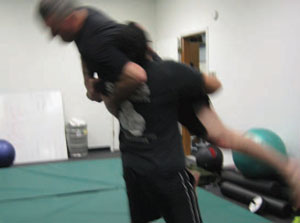
Metabolic Conditioning
Conditioning is imperative to combat sports like Brazilian Jiu-jitsu. All the strength and finely honed technique in the world don't matter if you are tired after two minutes. Plenty of folks have been beaten by less skilled but better conditioned opponents. It is one of the variables we have a lot of control over, so let's make the most of it.
My other two workouts during the week are conditioning. It's a good idea to vary the modalities and strength qualities during these routines. One of them will usually be a faster, harder effort, emphasizing power, power endurance, and explosiveness. Some of my favorites include:
Ross Enamait's Magic 50
Crossfit's Fight Gone Bad
3 rounds of:
-10 sandbag shoulders per side
-row 500m
-Kettlebell rack walk specified distance
-10 sandbag clean and press
-hand fight with partner to bodylock 1 min
-20 guard sit-ups with partner
-rest one min
-repeat for rounds
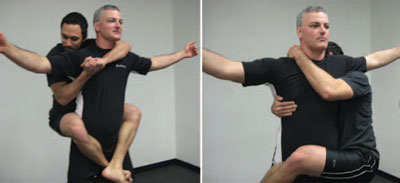
These workouts usually involve weighted implements, at least to some degree, and generally make me want to puke at the end. My metabolic conditioning tends to tank before my muscular endurance. I liken them to that grappling match when you are dead tired, manage to hang on and submit the guy, but then run to the bathroom. These kinds of workouts generally leave me sore, so my other metcon workout is usually a bit different. It might utilize movements that are a bit more bodyweight based and easier on a rep for rep basis. Something like:
Crossfit's Cindy, Mary, or Helen
A series of sprint intervals
3 rounds of:
-Row 500m
-20 wall balls
-10 renegade rows per side
-rest 1 min
These workouts are by no means easy, but they should not be as taxing as the previous metcon during the week. One thing I like to do when laying out these various metcons is to think about positions on the mat and try to model the work/rest ratio or muscular action. If I am struggling with muscular endurance when taking someone's back, I might work in some sandbag carries, as well as static rope hangs for grip. One of the unique aspects about grappling is that it requires a lot of isometric contraction with various limbs. We are either grabbing our opponent with our hands, or trying to hang onto his body and limbs with our arms and legs. Things like guard sit-ups on a hanging heavy bag or the monkey drill with a partner can easily be programmed into a workout. With the monkey drill, a partner stands while you jump on his back, and work your way around his body without touching the ground, finishing on the back position.
Explosive Strength
There are a lot of options when training explosiveness. Box jumps, broad jumps, plyometric push up variations, explosive pull-ups, as well as lifts with various implements. What about the Olympic lifts? It's up to the individual—how much training time you have and how it's going to impact your BJJ. The athlete that has more time to train can maybe work in an O-lifting skill sessions in the morning, then incorporate them into workouts once technique is up to snuff. Explosive movements can be programmed in during the strength days, as well as be a component of metcons. However, if you don't have a lot of time to begin with, because O-lifting requires a considerable amount of technique before you'll get a lot of benefit, your time may be better spent on movements with an easier learning curve.
Variety
Keep in mind that the above template is just one variation and folks will have different needs, thus calling for different programming. The 5'10", 140-lb guy who has never played a sport but wants to try BJJ may be better served doing more strength training and putting on some muscle. The former D1 football player or wrestler that now has a desk job may already be plenty strong and might want to just concentrate on conditioning and BJJ technique, at least in the beginning.
Some folks will have the ability to train on their lunch hour as well, or in the mornings. You can use this opportunity to get in two workouts a day, perhaps conditioning in the morning and BJJ at night. This can allow for more off days during the week.
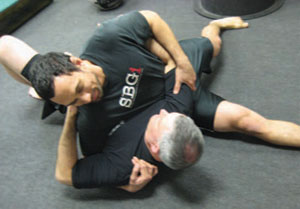
Wrap Up
In the end it’s all about what works for you. Think about your needs, keep a training log, and pay attention to your progress on the mat.
I work a regular 9-5 job and have limited time to train. Most of it takes place on the evenings and weekends. I can't eat, sleep and train like a professional. I am no longer in school, so no more going to class two days a week and training the rest of the time. I miss those days, but can still make the best of my current schedule.
I would like to give credit to others that have influenced my thinking on training for combat sports. I have absorbed information from a lot of sources, but two main ones have been Ross Enamait and Robb Wolf. I have really gotten a lot out of reading their writing over the past few years and applying things to my own training.
Priorities
First, as a BJJ practitioner you need to use your S&C to supplement your sport, not treat it as a sport in and of itself. The final word that matters is performance on the mat. I have this problem myself. I go into Crossfit Portland and want to do as well as the folks who only do Crossfit. This often isn't going to be the case. You may be fatigued from a grappling practice previously, or just not able to spend as much time on outside training as other folks. That's perfectly fine, as everyone has different goals.
Grappling involves many different strength qualities, which can make it kind of confusing to train for at first. Maximal strength, explosive strength, muscular endurance, as well as high levels of aerobic and anaerobic conditioning are needed. This multi-faceted approach requires a different training approach than for a lot of other sports.
For me, the most important thing to get in grappling shape is to grapple. No amount of extra work replaces time on the mat. So it's important to figure out how much grappling practice you want to attend, and then base your extra work around that. For me, 3 times a week is the minimum required to maintain a consistent level of BJJ. Any less and my timing and technique start to feel sluggish, and my mat-specific conditioning starts to deteriorate. That leaves me three other days for extra training, as I need at least one day a week to sit on the couch.

Laying It Out
Here is an example of what my typical training week looks like.
Sunday
BJJ open mat: 2 hrs
Monday
Strength day, plus quick finisher.
Tuesday
Off
Wednesday
Metcon: Usually something demanding utilizing weighted implements.
Thursday
BJJ class: 1.5 hrs
Friday
Another metcon: something a little less demanding than Wednesday, or utilizing different modalities
Saturday
Sometimes a Metcon in the morning morning and BJJ class in the afternoon. Class is usually 2 hrs and heavy on the sparring.
Maximal Strength
In my experience maximal strength beyond a certain point does not have a huge payoff on the mat. I recently spent three months bringing up my barbell strength in the basic lifts. I got much stronger under the bar, but did not notice a huge payoff when it came to BJJ. In fact, during certain practices my performance suffered because I was still tired from the strength workout the day before. At a BW of 175, my PRs are a deadlift of 375, standing press 145, squat 300, and bench 195. Strength-wise I am nothing special. Yet I get beat by folks all the time who I know don't even lift weights. Technique matters so much. I'm not saying not to lift and get strong, but after a certain point will bringing up your squat fifty pounds really improve your grappling ability that much? Your time would be better spent on the mat. Each athlete needs to evaluate his or her individual needs. Are you being easily overpowered and muscled around? Some more additional strength and muscle mass might be in order. Stronger muscles also mean more protection for joints like the shoulders, which always take a beating in grappling.
On my maximal strength days, I like to do a lower body movement, pushing movement, and pulling movement. I got this from Robb Wolf in his Fight Prep article. It’s simple, effective, and not overly taxing. I keep the weight heavy and the rep ranges low, usually 3x3 on the barbell movements and 3x5 on dips or chins. I might do deadlifts, presses and weighted chins. Or squats, ring dips, and rope climbs. I usually stick with the same strength movements for three weeks, increasing the weight every week. Then take a back off week, and start with a new set of movements. On strength days I also like to employ a quick finisher of some sort. Something like Crossfit's Baseline Workout, 30/30 Kettlebell swings for a specified time, or a quick lap or two of a sandbag carry.

Metabolic Conditioning
Conditioning is imperative to combat sports like Brazilian Jiu-jitsu. All the strength and finely honed technique in the world don't matter if you are tired after two minutes. Plenty of folks have been beaten by less skilled but better conditioned opponents. It is one of the variables we have a lot of control over, so let's make the most of it.
My other two workouts during the week are conditioning. It's a good idea to vary the modalities and strength qualities during these routines. One of them will usually be a faster, harder effort, emphasizing power, power endurance, and explosiveness. Some of my favorites include:
Ross Enamait's Magic 50
Crossfit's Fight Gone Bad
3 rounds of:
-10 sandbag shoulders per side
-row 500m
-Kettlebell rack walk specified distance
-10 sandbag clean and press
-hand fight with partner to bodylock 1 min
-20 guard sit-ups with partner
-rest one min
-repeat for rounds

These workouts usually involve weighted implements, at least to some degree, and generally make me want to puke at the end. My metabolic conditioning tends to tank before my muscular endurance. I liken them to that grappling match when you are dead tired, manage to hang on and submit the guy, but then run to the bathroom. These kinds of workouts generally leave me sore, so my other metcon workout is usually a bit different. It might utilize movements that are a bit more bodyweight based and easier on a rep for rep basis. Something like:
Crossfit's Cindy, Mary, or Helen
A series of sprint intervals
3 rounds of:
-Row 500m
-20 wall balls
-10 renegade rows per side
-rest 1 min
These workouts are by no means easy, but they should not be as taxing as the previous metcon during the week. One thing I like to do when laying out these various metcons is to think about positions on the mat and try to model the work/rest ratio or muscular action. If I am struggling with muscular endurance when taking someone's back, I might work in some sandbag carries, as well as static rope hangs for grip. One of the unique aspects about grappling is that it requires a lot of isometric contraction with various limbs. We are either grabbing our opponent with our hands, or trying to hang onto his body and limbs with our arms and legs. Things like guard sit-ups on a hanging heavy bag or the monkey drill with a partner can easily be programmed into a workout. With the monkey drill, a partner stands while you jump on his back, and work your way around his body without touching the ground, finishing on the back position.
Explosive Strength
There are a lot of options when training explosiveness. Box jumps, broad jumps, plyometric push up variations, explosive pull-ups, as well as lifts with various implements. What about the Olympic lifts? It's up to the individual—how much training time you have and how it's going to impact your BJJ. The athlete that has more time to train can maybe work in an O-lifting skill sessions in the morning, then incorporate them into workouts once technique is up to snuff. Explosive movements can be programmed in during the strength days, as well as be a component of metcons. However, if you don't have a lot of time to begin with, because O-lifting requires a considerable amount of technique before you'll get a lot of benefit, your time may be better spent on movements with an easier learning curve.
Variety
Keep in mind that the above template is just one variation and folks will have different needs, thus calling for different programming. The 5'10", 140-lb guy who has never played a sport but wants to try BJJ may be better served doing more strength training and putting on some muscle. The former D1 football player or wrestler that now has a desk job may already be plenty strong and might want to just concentrate on conditioning and BJJ technique, at least in the beginning.
Some folks will have the ability to train on their lunch hour as well, or in the mornings. You can use this opportunity to get in two workouts a day, perhaps conditioning in the morning and BJJ at night. This can allow for more off days during the week.

Wrap Up
In the end it’s all about what works for you. Think about your needs, keep a training log, and pay attention to your progress on the mat.
| Anton Emery lives in Portland Oregon. He is a Level I Crossfit Trainer at Crossfit Portland, and a blue belt under Matt Thorton at the Straight Blast Gym. In his spare time he enjoys consuming new kinds of coffee and checking out different paleo-friendly restaurants around town. He can be reached at antonemery@gmail.com |
Search Articles
Article Categories
Sort by Author
Sort by Issue & Date
Article Categories
Sort by Author
Sort by Issue & Date

